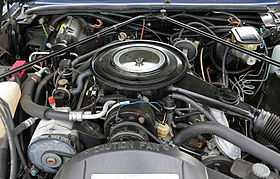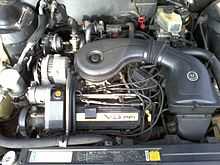Cadillac High Technology engine
| Cadillac High Technology engine | |
|---|---|
 | |
| Overview | |
| Manufacturer | Cadillac |
| Production | 1982-1995 |
| Combustion chamber | |
| Configuration | V8 |
| Displacement |
|
| Cylinder bore |
|
| Piston stroke |
|
| Cylinder block alloy | Aluminum |
| Cylinder head alloy | Cast iron |
| Valvetrain | Overhead valve |
| Compression ratio | 9.5:1 |
| Combustion | |
| Fuel system | |
| Fuel type | Gasoline |
| Oil system | Wet sump |
| Cooling system | Water-cooled |
| Output | |
| Power output |
|
| Torque output |
|
| Chronology | |
| Predecessor | Cadillac V8-6-4 engine |
| Successor | Cadillac Northstar engine |
The Cadillac High Technology Engine was a V8 engine produced by the Cadillac division of General Motors from 1982 to 1995. It was originally scheduled for a 1983 release, later delayed to 1985, with its intended applications being the downsized front-wheel drive models that Cadillac would introduce that year.
While the High Technology engine was being developed, due to higher Corporate Average Fuel Economy standards being phased in by the United States government, Cadillac introduced a variant of their traditional V8 engine with the world's first usage of cylinder deactivation for 1981 as a stopgap measure to increase the fuel economy of their lineup.
However, the V8-6-4 engine would experience a litany of unsolvable problems in drivability and reliability mostly due to the primitive state of engine control technologies at the time. Cadillac was then forced to rush development and production of the High Technology engine for a 1982 introduction in their current rear-wheel drive models.[1]
This would be the last engine family exclusive to the Cadillac division. Its successor, the Northstar would go on to share its architecture with the Oldsmobile Aurora in 1994 and later with flagship Pontiac and Buick models, while current Cadillac V8 models use the GM small-block engine, commonly identified with the Chevrolet division.
HT-4100

A new lighter V8 engine was rushed into production for 1982, the HT-4100 (option code LT8). It was a 4100 cc V8, designed for rear-wheel-drive and longitudinal front-wheel-drive applications sharing the same "Metric" transmission bellhousing pattern as Buick, Oldsmobile, and Pontiac rear- and front-wheel drivetrains for 2.5 L 4-cylinder and 2.8, 3.1, and 3.3 L V6. A new line of downsized Cadillac cars with the transverse mounted V8 engine was slated for 1983. However, delays in the downsizing program shared with Buick and Oldsmobile postponed the introduction of those models until 1985.
Design Features
HT stood for High Technology. For its time, the engine and its electronic control module (ECM) were quite sophisticated, despite having a throttle body injection system (as opposed to port fuel injection.) Like the 6.0/368" DFI engines before it, the HT4100 used an ECM that incorporated a detailed on-board computer. Every parameter of engine performance could be displayed on the Electronic Climate Control panel while the car was being driven. The HT4100 also pioneered other design features including replaceable cylinder sleeves, high operating temperature for emission control (210 degrees, compared to 180 in earlier engines), free circulation of coolant between the block and the heads, and bimetal construction that mounted heat-tolerant cast-iron heads onto a weight-saving aluminum block. The engine had a bore of 3.465 in (88.0 mm) and stroke of 3.307 in (84.0 mm), for a total displacement of 4.1 L (250 cu in). It initially was equipped with throttle-body fuel injection, with output of 135 hp (101 kW) at 4400 rpm and 190 lbf·ft (260 N·m) of torque at 2000 rpm.
In 1982 the HT4100 was the standard engine for the longitudinal front-wheel-drive Eldorado and Seville. It was also placed in many rear-wheel-drive DeVilles, and was available for the Fleetwood.
The HT4100 was prone to failure of the intake manifold gasket due to scrubbing of the bi-metal interface, aluminum oil pump failure, cam bearing displacement, weak aluminum block castings and bolts pulling the aluminum threads from the block. It may not have been the most successful engine to sit under the hood of a Cadillac, but potential buyers were no more satisfied with the other two engines available at the time, the V8-6-4 and the Oldsmobile 5.7 L Diesel. Reliability issues soiled the reputation of the HT4100. As a result, the V8 Oldsmobile gas engines were a popular and straightforward conversion.
Cadillac car sales remained strong, exceeding 100,000 in 1984. Cadillac's share of the luxury car market diminished rapidly after 1985 when GM decided to change to a smaller, more generic looking front-wheel drive platform, the C-Body . Since all GM cars shared the same platform and just had a different badge, many consumers would not see the reason to pay the extra money for the Cadillac when they could buy the same car with an Oldsmobile or Buick badge for less money. Also, the Oldsmobile and Buick versions came with much more reliable engines, the 5.0L Oldsmobile V8 for RWD vehicles and the 3.8L Buick V6 for FWD vehicles.[2]
For 1987 a more powerful version of the 4.1 L engine was introduced in the Cadillac Allanté, using a different camshaft profile and roller lifters to reduce friction, in addition to multiport fuel injection. This engine was rated at 170 hp (127 kW) at 4300 rpm and 235 lbf·ft (319 N·m) of torque at 3200 rpm. The 4.1 was superseded by larger-displacement engines, and ceased production after the 1988 model year.
4.5

An improved and enlarged version of the HT4100, the 4.5 L engine was never classified as HT4500.
Engineering allowed the company to begin increasing displacement and output again. A bored-out (to 92 mm (3.6 in)) 4.5 L (273 cu in) 4.5 version was introduced in 1988 with 155 hp (116 kW) and throttle body injection. Various versions of this engine were built from this introduction to the end of production in 1992 including a high-output LW2 version with multiport fuel injection which produced 200 hp (149 kW) and 270 lbf·ft (370 N·m) for the Allante. Outside of the Allante, Cadillac introduced a port fuel-injected 4.5 L V8 engine in 1990 with 180 hp (134 kW) and 245 lbf·ft (332 N·m) across their car line up.
L26 4.9

A larger version of the 4.5, the L26 4.9, debuted in 1991 at 4.9 L with a square 92 mm (3.6 in) bore and stroke. Despite the fact that it had similar output to Allante's 4.5 L port fuel-injected V8, the 4.9 L engine represented a significant upgrade for the remainder of the Cadillac lineup. Horsepower output was up 20 hp (15 kW) from the previous 1990 4.5 L engine and torque was up by 30 lbf·ft (41 N·m), to 200 hp (149 kW) and 275 lbf·ft (373 N·m) respectively. Both the 4.9 and 4.5 port fuel-injected engines required premium fuel due to a 9.5:1 compression ratio. The 4.9 produces its maximum horsepower at 4100 rpm.
The 4.9 L was used throughout the Cadillac line. It was replaced by the newer 4.6 L Cadillac Northstar engine.
References
- ↑ Sessler, Peter (2010). Ultimate American V-8 Engine Data Book, 2nd Edition. Minneapolis: Motorbooks. pp. 28, 29. ISBN 978-0760336816.
- ↑ the Auto Editors of Consumer Guide. "HowStuffWorks "1980-1989 Cadillac"". Auto.howstuffworks.com. Retrieved 2010-06-12.